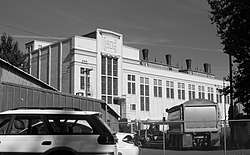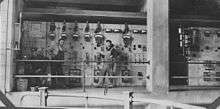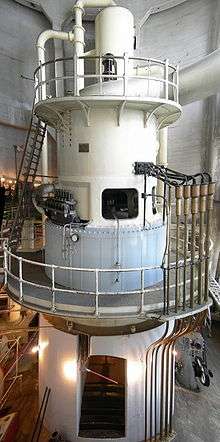Georgetown Steam Plant
The Georgetown Steam Plant, located in the Georgetown neighborhood of Seattle, Washington, was constructed in 1906 for the Seattle Electric Company to provide power for Seattle, notably for streetcars.
Seattle Electric Company Georgetown Steam Plant | |
 | |
| Location | Seattle, Washington |
|---|---|
| Coordinates | 47°32′34.02″N 122°18′57.74″W |
| Built | 1906 |
| Architect | Stone & Webster Engineering; Frank B. Gilbreth |
| Architectural style | Classical Revival |
| NRHP reference No. | 78002755 |
| Significant dates | |
| Added to NRHP | August 1, 1978[1] |
| Designated NHL | July 5, 1984[2] |
| Designated SEATL | September 10, 1984[3] |
History
The plant was originally built by Stone and Webster in 1906. One of the first reinforced concrete structures on the U.S. West Coast, it originally provided power for the Interurban Railway between Seattle and Tacoma; it also provided both direct current for Seattle's streetcars and alternating current for Georgetown, then an independent city. They purchased General Electric steam turbine technology, based on patents originally held by inventor Charles Gordon Curtis. At the time, this was cutting edge technology, and the Georgetown Steam Plant "marks the beginning of the end of the reciprocating steam engine" as the dominant mode of generating electricity on a large scale.[4]

Originally located along an oxbow of the Duwamish River to provide cooling water, the plant was left inland after the original river channel was straightened in 1917. Retired after nearly 75 years of operation, it remains "surprisingly complete and operable". The plant has three Curtis turbines, manufactured by the General Electric Company between 1906 and 1917.[5]
Puget Sound Traction and Lighting Company (now Puget Sound Energy) bought the Seattle Electric Company in 1912; the Georgetown Steam Plant powered the Seattle-to-Tacoma Interurban and Seattle streetcars; it also provided residential and industrial power to Georgetown. Originally an oil-fired plant, it converted to a coal in 1917.[5] As hydropower was developed in the 1910s and 1920s the steam plant became uncompetitive and only used for emergencies. It last produced electricity in January 1953 when water levels at the dams were low.[6] Decommissioning took place in 1972.[7]
Landmark and museum
The building was declared a National Historic Landmark in 1984,[2] and is also designated by the American Society of Mechanical Engineers as a National Historic Mechanical Engineering Landmark.[8] At the time of its landmarking, it contained the "last operating examples of the world's first large scale, steam turbine".[9] The building itself, "built by a fast-track construction process, was designed and supervised by Frank W. Gilbreth, later a nationally famous proponent of efficiency engineering."[9] The building is also a Seattle City Landmark[10] and is on the Washington State Register of Historic Places.[4]

Paul Carosino and Lilly Tellefson founded the Georgetown PowerPlant Museum in 1995 to restore, maintain and operate the plant. It now teaches boiler firemen and steam engineers.[11]
The plant remains owned by Seattle City Light, the city's public electric utility. Since 2014 it has opened to the general public once a month,[12] from 10am to 2pm on the second Saturday of each month.[13]
The plant houses the last operable examples of early vertical Curtis steam generating turbines,[12] as well as operational reciprocating steam engines, a collection of vintage machining tools, and several smaller steam engines.[4]
The plant was the site of the last performance of the rock band Big Black.[14]
Notes

- "National Register Information System". National Register of Historic Places. National Park Service. July 9, 2010.
- "Seattle Electric Company Georgetown Steam Plant". National Historic Landmark summary listing. National Park Service. 2007-09-17. Archived from the original on 2008-01-30. Retrieved 2007-12-28.
- "Landmarks and Designation". City of Seattle. Retrieved 2013-03-04.
- Georgetown Powerplant Museum brochure.
- ASME Historic Mechanical Engineering Landmarks #45, accessed online 25 August 2007.
- O'Hagan, Maureen (2015-05-14). "Tour an electrical time machine: The Georgetown Steam Plant". The Seattle Times. Retrieved 2019-03-04.
- "Georgetown Steam Plant". Historic Seattle. Retrieved 2019-03-04.
- "Georgetown Steam Plant". American Society of Mechanical Engineers. Retrieved March 3, 2019.
- Thomas & Allan 1984, p. 24
- Landmarks Alphabetical Listing for G Archived 2011-07-21 at the Wayback Machine, Individual Landmarks, Department of Neighborhoods, City of Seattle. Accessed 28 December 2007.
- "Learn with Us". Georgetown PowerPlant Museum. Retrieved 2019-03-04.
- Millman, Zosha (2018-03-15). "What's next for Georgetown Steam Plant? Maybe a museum". seattlepi.com. Retrieved 2019-03-04.
- "Georgetown Steam Plant". www.seattle.gov. Retrieved 2019-03-04.
- Big Black: The Last Blast, New York Times / Allmusic review. Accessed online 19 January 2008.
References
- Thomas, Jacob; Allan, T. (1984-01-27). "National Register of Historic Places Inventory Nomination: Seattle Electric Company Georgetown Steam Plant" (PDF). National Park Service. p. 57. Retrieved 2007-12-28.. PDF: 425 KiB.
- Seattle Electric Company Georgetown Steam Plant--Accompanying 5 photos, exterior and interior, undated (1.06 MB), National Register of Historic Places Inventory Nomination, National Park Service, 1984. Accessed 28 December 2007.
- "Historic American Engineering Record report on Georgetown Steam Plant". Historic American Engineering Record. 1984. Retrieved 2009-02-13..
External links
| Wikimedia Commons has media related to Georgetown PowerPlant Museum. |
- Georgetown Steam Plant - City of Seattle
- ASME Historic Mechanical Engineering Landmarks #45 - Information on the museum
- Seattle Electric Company's Georgetown Steam Plant - National Park Service